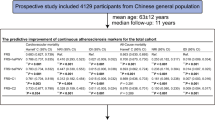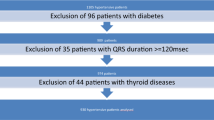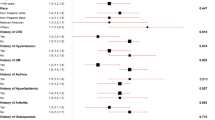Abstract
Few studies have addressed the predictive value of arterial stiffness determined by pulse wave velocity (PWV) in a high-risk population with no prevalent cardiovascular disease and with obesity, hypertension, hyperglycemia, and preserved kidney function. This longitudinal, retrospective study enrolled 88 high-risk patients and had a follow-up time of 12.4 years. We collected clinical and laboratory data, as well as information on arterial stiffness parameters using arterial tonometry and measurements from ambulatory blood pressure monitoring. We considered nonfatal, incident cardiovascular events as the primary outcome. Given the small size of our dataset, we used survival analysis (i.e., Cox proportional hazards model) combined with a machine learning-based algorithm/penalization method to evaluate the data. Our predictive model, calculated with Cox regression and least absolute shrinkage and selection operator (LASSO), included body mass index, diabetes mellitus, gender (male), and PWV. We recorded 16 nonfatal cardiovascular events (5 myocardial infarctions, 5 episodes of heart failure, and 6 strokes). The adjusted hazard ratio for PWV was 1.199 (95% confidence interval: 1.09–1.37, p < 0.001). Arterial stiffness was a predictor of cardiovascular disease development, as determined by PWV in a high-risk population. Thus, in obese, hypertensive, hyperglycemic patients with preserved kidney function, PWV can serve as a prognostic factor for major adverse cardiac events.




Similar content being viewed by others
Data availability
According to the contract signed with Mostoles University Hospital, which provided the database, we cannot provide our database to any other researcher. Furthermore, we must destroy the database once our investigation has been concluded.
Abbreviations
- BP:
-
Blood pressure
- PWV:
-
Pulse wave velocity
- CV:
-
Cardiovascular
- CVD:
-
Cardiovascular disease
- AIx:
-
Augmentation index of aortic pressure
- ABPM:
-
Ambulatory blood pressure monitoring
- MS:
-
Metabolic syndrome
- T2DM:
-
Type 2 diabetes mellitus
- HbA1c:
-
Glycated hemoglobin
- EPV:
-
Events per variables
- LASSO:
-
Least absolute shrinkage and selection operator
- ACR:
-
Albumin/creatinine ratio
- MACE:
-
Major adverse cardiovascular event
- MSE:
-
Mean square error
- GFR:
-
Glomerular filtration rate
- BMI:
-
Body mass index
- RF:
-
Random forest
References
Lewington, S., Clarke, R., Qizilbash, N., Peto, R., and Collins, R., Prospective studies collaboration. Age-specific relevance of usual blood pressure to vascular mortality: A meta-analysis of individual data for one million adults in 61 prospective studies. Lancet [Internet]. 360(9349):1903–1913, 2002 Available from: https://doi.org/10.1016/S0140-6736(02)11911-8.
Wang, K.-L., Cheng, H.-M., Chuang, S.-Y., Spurgeon, H. A., Ting, C.-T., Lakatta, E. G. et al., Central or peripheral systolic or pulse pressure: Which best relates to target organs and future mortality? J Hypertens [Internet]. 27(3):461–467, 2009 Available from: http://europepmc.org/articles/PMC3178100.
Zhang, L., Wang, Z., Chen, Z., Wang, X., Tian, Y., Shao, L. et al., Central aortic systolic blood pressure exhibits advantages over brachial blood pressure measurements in chronic kidney disease risk prediction in women. Kidney Blood Press Res [Internet]. 43(4):1375–1387, 2018 Available from: https://www.karger.com/DOI/10.1159/000492952.
Zanchetti A, Dominiczak A, Coca A, Tsioufis C, Clement DL, Agabiti Rosei E, et al. 2018 ESC/ESH Guidelines for the management of arterial hypertension. Eur Heart J [Internet]. 2018 25;39(33):3021–104. Available from: https://doi.org/10.1093/eurheartj/ehy339
Willum-Hansen, T., Staessen, J. A., Torp-Pedersen, C., Rasmussen, S., Thijs, L., Ibsen, H., and Jeppesen, J., Prognostic value of aortic pulse wave velocity as index of arterial stiffness in the general population. Circulation. 113(5):664–670, 2006.
Sutton-Tyrrell, K., Najjar, S. S., Boudreau, R. M., Venkitachalam, L., Kupelian, V., Simonsick, E. M., Havlik, R., Lakatta, E. G., Spurgeon, H., Kritchevsky, S., Pahor, M., Bauer, D., Newman, A., and Health ABC Study, Elevated aortic pulse wave velocity, a marker of arterial stiffness, predicts cardiovascular events in well-functioning older adults. Circulation 111(25):3384–3390, 2005.
Cruickshank, K., Riste, L., Anderson, S. G., Wright, J. S., Dunn, G., and Gosling, R. G., Aortic pulse-wave velocity and its relationship to mortality in diabetes and glucose intolerance: An integrated index of vascular function? Circulation 106(16):2085–2090, 2002.
O’Brien, E., Atkins, N., Stergiou, G., Karpettas, N., Parati, G., and Asmar, R., European Society of Hypertension International Protocol revision 2010 for the validation of blood pressure measuring devices in adults (vol 15, pg 23, 2010). BLOOD Press Monit. 15(3):171–172, 2010.
Townsend, R. R., Wimmer, N. J., Chirinos, J. A., Parsa, A., Weir, M., Perumal, K., Lash, J. P., Chen, J., Steigerwalt, S. P., Flack, J., Go, A. S., Rafey, M., Rahman, M., Sheridan, A., Gadegbeku, C. A., Robinson, N. A., and Joffe, M., Aortic PWV in chronic kidney disease: A CRIC ancillary study. Am J Hypertens. 23(3):282–289, 2010.
Executive summary of the third report of the national cholesterol education program (NCEP), Expert Panel on detection, evaluation, and treatment of high blood cholesterol in adults (adult treatment panel III). JAMA 285(19):2486–2497, 2001 Available from: https://doi.org/10.1001/jama.285.19.2486.
Classification and Diagnosis of Diabetes: Standards of Medical Care in Diabetes—2018. Diabetes Care [Internet]. 2018 1;41(Supplement 1):S13 LP-S27. Available from: http://care.diabetesjournals.org/content/41/Supplement_1/S13.abstract
Levey, A. S., Stevens, L. A., Schmid, C. H., Zhang, Y. L., Castro, A. F., Feldman, H. I. et al., A new equation to estimate glomerular filtration rate. Ann Intern Med. 150(9):604–612, 2009.
Oliveras A, García-Ortiz L, Segura J, Banegas JR, Martell-Claros N, Vigil L, et al. Association between urinary albumin excretion and both central and peripheral blood pressure in subjects with insulin resistance. J Hypertens [Internet]. 2013;31(1). Available from: http://journals.lww.com/jhypertension/Fulltext/2013/01000/Association_between_urinary_albumin_excretion_and.17.aspx
R Core Team. R: A Language and Environment for Statistical Computing. Vienna, Austria; 2017.
Pavlou, M., Ambler, G., Seaman, S. R., Guttmann, O., Elliott, P., King, M. et al., How to develop a more accurate risk prediction model when there are few events. BMJ. 351:h3868, 2015.
Concato, J., Peduzzi, P., Holford, T. R., and Feinstein, A. R., Importance of events per independent variable in proportional hazards analysis I. background, goals, and general strategy. J Clin Epidemiol. 48(12):1495–1501, 1995.
Ambler, G., Seaman, S., and Omar, R. Z., An evaluation of penalised survival methods for developing prognostic models with rare events. Stat Med. 31(11–12):1150–1161, 2012.
Goeman, J. J., L1 Penalized Estimation in the Cox Proportional Hazards Model. Biometrical J [Internet] 52(1):70–84, 2010 Available from: https://doi.org/10.1002/bimj.200900028.
Simon, N., Friedman, J., Hastie, T., and Tibshirani, R., Regularization paths for Cox’s Proportional Hazards Model via coordinate descent. J Stat Softw. 39(5):1–13, 2011.
Tibshirani, R., The lasso method for variable selection in the Cox model. Stat Med. 16(4):385–395, 1997.
Collins, G. S., Reitsma, J. B., Altman, D. G., and Moons, K. G. M., Transparent reporting of a multivariable prediction model for individual prognosis or diagnosis (TRIPOD): the TRIPOD statement. BMC Med [Internet] 13(1):1, 2015 Available from: https://doi.org/10.1186/s12916-014-0241-z.
James G, Witten D, Hastie T, Tibshirani R. An introduction to statistical learning. Vol. 112. Springer; 2013.
Kohavi R. A study of cross-validation and bootstrap for accuracy estimation and model selection. In: Ijcai. Montreal, Canada; 1995. p. 1137–45.
Tang J, Alelyani S, Liu H. Feature selection for classification: A review. Data Classif Algorithms Appl. 2014;37.
Liaw, A., and Wiener, M., Classification and regression by randomForest. R News. 2(3):18–22, 2002.
Sowa, J.-P., Atmaca, Ö., Kahraman, A., Schlattjan, M., Lindner, M., Sydor, S. et al., Non-invasive separation of alcoholic and non-alcoholic liver disease with predictive modeling. PLoS One [Internet] 9(7):e101444–e101444, 2014 Available from: https://www.ncbi.nlm.nih.gov/pubmed/24988316.
Sowa, J.-P., Heider, D., Bechmann, L. P., Gerken, G., Hoffmann, D., and Canbay, A., Novel algorithm for non-invasive assessment of fibrosis in NAFLD. PLoS One [Internet] 8(4):e62439–e62439, 2013 Available from: https://www.ncbi.nlm.nih.gov/pubmed/23638085.
Khunti, K., Walker, N., Sattar, N., and Davies, M., Unanswered questions over NHS health checks. BMJ. 342:c6312, 2010.
Mann, J. F. E., Yi, Q.-L., and Gerstein, H. C., Albuminuria as a predictor of cardiovascular and renal outcomes in people with known atherosclerotic cardiovascular disease. Kidney Int Suppl. 92:S59–S62, 2004.
Kramer, H., Jacobs, D. R. J., Bild, D., Post, W., Saad, M. F., Detrano, R. et al., Urine albumin excretion and subclinical cardiovascular disease. The Multi-Ethnic Study of Atherosclerosis. Hypertens (Dallas, Tex 1979) 46(1):38–43, 2005.
Van Bortel, L. M., Laurent, S., Boutouyrie, P., Chowienczyk, P., Cruickshank, J. K., De Backer, T. et al., Expert consensus document on the measurement of aortic stiffness in daily practice using carotid-femoral pulse wave velocity. J Hypertens. 30(3):445–448, 2012.
Payne, R. A., Wilkinson, I. B., and Webb, D. J., Arterial stiffness and hypertension: emerging concepts. Hypertens (Dallas, Tex 1979) 55(1):9–14, 2010.
Ben-Shlomo, Y., Spears, M., Boustred, C., May, M., Anderson, S. G., Benjamin, E. J., Boutouyrie, P., Cameron, J., Chen, C. H., Cruickshank, J. K., Hwang, S. J., Lakatta, E. G., Laurent, S., Maldonado, J., Mitchell, G. F., Najjar, S. S., Newman, A. B., Ohishi, M., Pannier, B., Pereira, T., Vasan, R. S., Shokawa, T., Sutton-Tyrell, K., Verbeke, F., Wang, K. L., Webb, D. J., Willum Hansen, T., Zoungas, S., McEniery, C., Cockcroft, J. R., and Wilkinson, I. B., Aortic pulse wave velocity improves cardiovascular event prediction: An individual participant meta-analysis of prospective observational data from 17,635 subjects. J Am Coll Cardiol. 63(7):636–646, 2014.
Babińska, M., Chudek, J., Chełmecka, E., Janik, M., Klimek, K., and Owczarek, A., Limitations of cox proportional hazards analysis in mortality prediction of patients with acute coronary syndrome. Stud Logic, Gramm Rhetor. 43(1):33–48, 2015.
Ojeda, F. M., Müller, C., Börnigen, D., Tregouet, D.-A., Schillert, A., Heinig, M. et al., Comparison of cox model methods in a low-dimensional setting with few events. Genomics Proteomics Bioinformatics. 14(4):235–243, 2016.
Benner, A., Zucknick, M., Hielscher, T., Ittrich, C., and Mansmann, U., High-dimensional Cox models: the choice of penalty as part of the model building process. Biometrical J. 52(1):50–69, 2010.
Scuteri, A., Orru’, M., Morrell, C. H., Tarasov, K., Schlessinger, D., Uda, M. et al., Associations of large artery structure and function with adiposity: Effects of age, gender, and hypertension. The SardiNIA study. Atherosclerosis. 221(1):189–197, 2012.
Koumaras, C., Tziomalos, K., Stavrinou, E., Katsiki, N., Athyros, V. G., Mikhailidis, D. P., and Karagiannis, A., Effects of renin-angiotensin-aldosterone system inhibitors and beta-blockers on markers of arterial stiffness. J Am Soc Hypertens. 8(2):74–82, 2014.
Acknowledgments
The authors would like to thank Blanca San Jose Montano, the Health Science Librarian-Documentalist of our institution, for her great support, suggestions, and encouragement in the development of this manuscript.
Author information
Authors and Affiliations
Contributions
Dr. Garcia-Carretero designed and conceived the study, pre-processed the database, and made substantial contributions to the analyses and interpretation of data. He wrote the first draft of this paper. Dr. Vigil-Medina contributed to the recruitment of patients involved in this study. Dr. Barquero-Perez and Dr. Ramos-Lopez, as thesis advisors, critically reviewed the final manuscript.
Corresponding author
Ethics declarations
Ethical approval
All procedures involving human participants were conducted in accordance with the ethical standards of the responsible institutional and/or national research committee and with the 1964 Helsinki Declaration and its later amendments or comparable ethical standards. Our research was approved by our Ethics and Research Committee.
Consent to participate
Given that our research was retrospective and was approved by our Research Committee, the need to obtain consent was waived.
Consent for publication
We obtained a consent for publication from our own institution and our Ethics and Research Committee.
Competing interests
All authors declare that they have no conflicts of interest.
Additional information
Publisher’s Note
Springer Nature remains neutral with regard to jurisdictional claims in published maps and institutional affiliations.
This article is part of the Topical Collection on Systems-Level Quality Improvement
Rights and permissions
About this article
Cite this article
Garcia-Carretero, R., Vigil-Medina, L., Barquero-Perez, O. et al. Pulse Wave Velocity and Machine Learning to Predict Cardiovascular Outcomes in Prediabetic and Diabetic Populations. J Med Syst 44, 16 (2020). https://doi.org/10.1007/s10916-019-1479-y
Received:
Accepted:
Published:
DOI: https://doi.org/10.1007/s10916-019-1479-y




